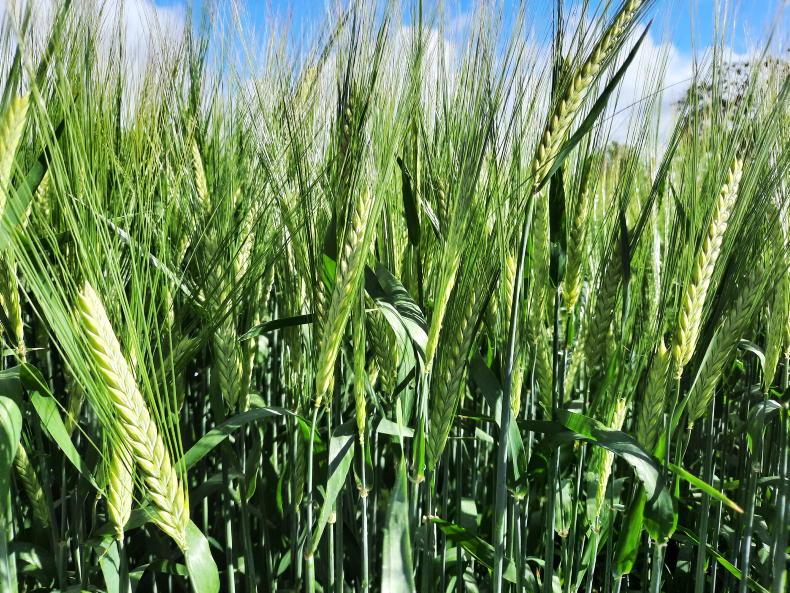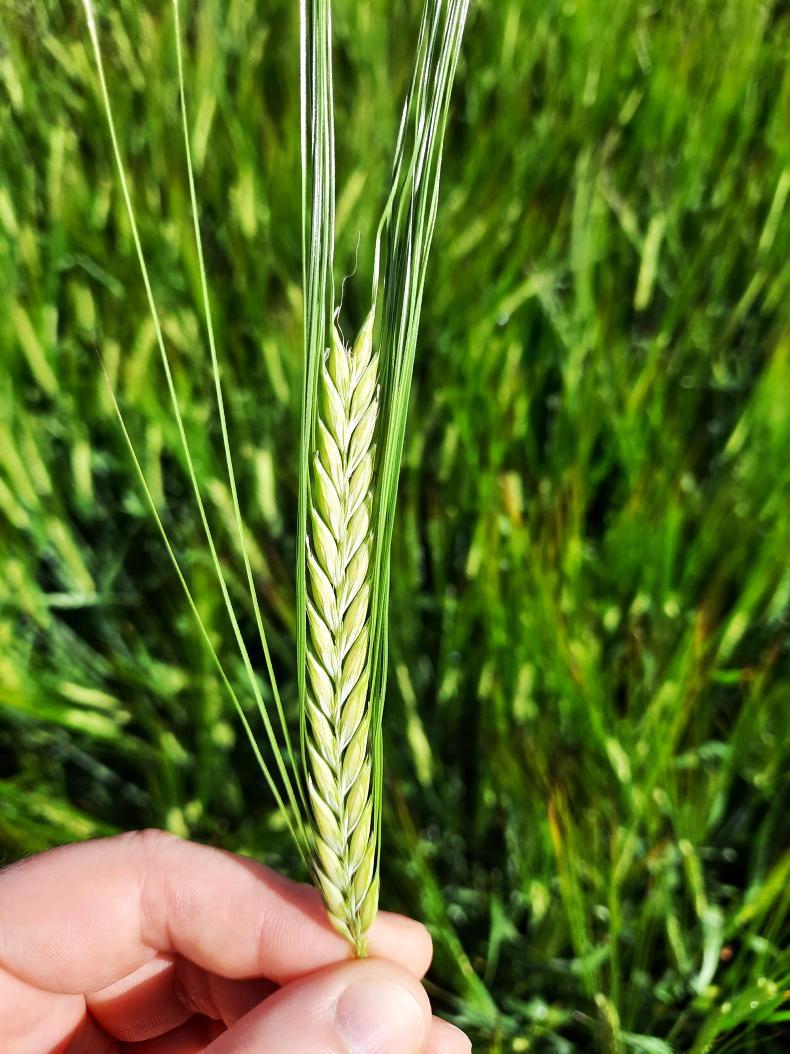Pádraig Connery is the next of our Footprint Farmers to be introduced. Pádraig farms mainly tillage between the villages of Villierstown and Clashmore in Co Waterford, while he also finishes cattle.
Variety is a key part of the sustainability strategy on this farm.
Variety in crops helps with economic, social, and environmental sustainability, while the addition of slurry and farmyard manure helps with soil health and lowering fertiliser bills.
Tillage is the main enterprise and Pádraig has a great mix of crops which is good from a risk point of view, not only for price, but also to spread risk across crops which may be affected by weather or a particular disease in a certain year.

Spring barley on Pádraig’s farm last summer.
Crops are mixed in terms of premiums with a good percentage of malting, seed, food-grade oats and high-yielding winter feed crops. Cereals are the main crop with winter and spring barley, winter wheat and winter oats.
This mix of crops is very important to spread the workload at the busy times of sowing and harvesting, and it also spreads the workload of spraying and fertiliser spreading. This takes out big pressure points in the season and helps to improve timings for planting, fertiliser and spraying as the amount of ground to be covered on a particular day is diluted.
It is important to spread out harvesting dates.

KWS Tardis winter barley on Pádraig’s farm.
This reduces the risk of crop loss due to weather or crop breakdown as crops will ripen at different times. It takes the pressure off the drivers.
Pádraig knows that his farm will be significantly affected by the next CAP and feels the programme may gradually prepare him for these changes.
Open mind
“I’m delighted to be part of this programme and I am approaching it with a very open mind.
“I’m looking forward to diving deeper into the financial sustainability side of things, while identifying and implementing environmental actions with long-term benefits and obtaining a degree of readiness for the next CAP reforms.”
“Soil health and the use of technology are two areas of interest to me here.
“In terms of social sustainability, maybe I’ll finally unearth an agri-related business idea that might complement the quieter winter months on a tillage farm,” Pádraig said.

In recent years, Pádraig has embraced cover crops and has had some great crops of biomass. When we walked the crops in the summer, it was clear that ground where cover crops had been planted was producing thicker cash crops. As we moved from one field to the next, crops were harder to walk through following cover crops and showed good colour. Cover crops are planted ahead of spring crops and last year a common mix used was phacelia and vetch.
These cover crops take up nutrients over the winter and so will allow Pádraig to cut back slightly on nitrogen in the following crops. Soil structure and organic matter levels should also improve with these crops.
Looking at Pádraig’s soil sample results, the soil pH is good on tillage ground, but is slightly lower on grassland, probably a sign of the main tillage enterprise being the focus. Much of the tillage ground had a soil pH of between 6.4 and 6.9.
As some fields had already received slurry when soil sampling last spring they have been sampled in recent weeks and represent traditionally fertile fields, so may help to bring up the average indices.
In the samples to hand at present Ps and Ks need some work at an average level of 2.

In 2021, Pádraig availed of the straw chopping scheme on his oat crops. This practice will return P and K to the ground and help to improve the soil indices over time. It will also help to improve soil structure and can reduce diesel use with continued improvement in soil health and structure.
Pádraig chopped oaten straw which there is slightly less demand for. This helped to reduce workload. While straw did need to be incorporated it cut out any work with turning, baling or loading.
Looking at Pádraig’s yields from last season, he is doing well and focus may need to turn to where cuts on inputs can be made, while maintaining yields. The average winter wheat yield on the farm this year was 10.4t/ha. Winter barley was at 9.8t/ha at very low moisture contents, while winter oats and spring barley both came in at 8.9t/ha. With fertiliser costs high this season, this will be an area to examine to see if reductions can be made. Pádraig already uses cattle and pig slurry on farm.
Farmer: Pádraig Connery.Location: Villierstown, Co Waterford.Farm size: 165ha.Enterprise: tillage
and beef.Average soil results
Soil pH – 6.3.Phosphorus – 2.Potassium – 2.
Pádraig Connery is the next of our Footprint Farmers to be introduced. Pádraig farms mainly tillage between the villages of Villierstown and Clashmore in Co Waterford, while he also finishes cattle.
Variety is a key part of the sustainability strategy on this farm.
Variety in crops helps with economic, social, and environmental sustainability, while the addition of slurry and farmyard manure helps with soil health and lowering fertiliser bills.
Tillage is the main enterprise and Pádraig has a great mix of crops which is good from a risk point of view, not only for price, but also to spread risk across crops which may be affected by weather or a particular disease in a certain year.

Spring barley on Pádraig’s farm last summer.
Crops are mixed in terms of premiums with a good percentage of malting, seed, food-grade oats and high-yielding winter feed crops. Cereals are the main crop with winter and spring barley, winter wheat and winter oats.
This mix of crops is very important to spread the workload at the busy times of sowing and harvesting, and it also spreads the workload of spraying and fertiliser spreading. This takes out big pressure points in the season and helps to improve timings for planting, fertiliser and spraying as the amount of ground to be covered on a particular day is diluted.
It is important to spread out harvesting dates.

KWS Tardis winter barley on Pádraig’s farm.
This reduces the risk of crop loss due to weather or crop breakdown as crops will ripen at different times. It takes the pressure off the drivers.
Pádraig knows that his farm will be significantly affected by the next CAP and feels the programme may gradually prepare him for these changes.
Open mind
“I’m delighted to be part of this programme and I am approaching it with a very open mind.
“I’m looking forward to diving deeper into the financial sustainability side of things, while identifying and implementing environmental actions with long-term benefits and obtaining a degree of readiness for the next CAP reforms.”
“Soil health and the use of technology are two areas of interest to me here.
“In terms of social sustainability, maybe I’ll finally unearth an agri-related business idea that might complement the quieter winter months on a tillage farm,” Pádraig said.

In recent years, Pádraig has embraced cover crops and has had some great crops of biomass. When we walked the crops in the summer, it was clear that ground where cover crops had been planted was producing thicker cash crops. As we moved from one field to the next, crops were harder to walk through following cover crops and showed good colour. Cover crops are planted ahead of spring crops and last year a common mix used was phacelia and vetch.
These cover crops take up nutrients over the winter and so will allow Pádraig to cut back slightly on nitrogen in the following crops. Soil structure and organic matter levels should also improve with these crops.
Looking at Pádraig’s soil sample results, the soil pH is good on tillage ground, but is slightly lower on grassland, probably a sign of the main tillage enterprise being the focus. Much of the tillage ground had a soil pH of between 6.4 and 6.9.
As some fields had already received slurry when soil sampling last spring they have been sampled in recent weeks and represent traditionally fertile fields, so may help to bring up the average indices.
In the samples to hand at present Ps and Ks need some work at an average level of 2.

In 2021, Pádraig availed of the straw chopping scheme on his oat crops. This practice will return P and K to the ground and help to improve the soil indices over time. It will also help to improve soil structure and can reduce diesel use with continued improvement in soil health and structure.
Pádraig chopped oaten straw which there is slightly less demand for. This helped to reduce workload. While straw did need to be incorporated it cut out any work with turning, baling or loading.
Looking at Pádraig’s yields from last season, he is doing well and focus may need to turn to where cuts on inputs can be made, while maintaining yields. The average winter wheat yield on the farm this year was 10.4t/ha. Winter barley was at 9.8t/ha at very low moisture contents, while winter oats and spring barley both came in at 8.9t/ha. With fertiliser costs high this season, this will be an area to examine to see if reductions can be made. Pádraig already uses cattle and pig slurry on farm.
Farmer: Pádraig Connery.Location: Villierstown, Co Waterford.Farm size: 165ha.Enterprise: tillage
and beef.Average soil results
Soil pH – 6.3.Phosphorus – 2.Potassium – 2. 









 This is a subscriber-only article
This is a subscriber-only article










SHARING OPTIONS: